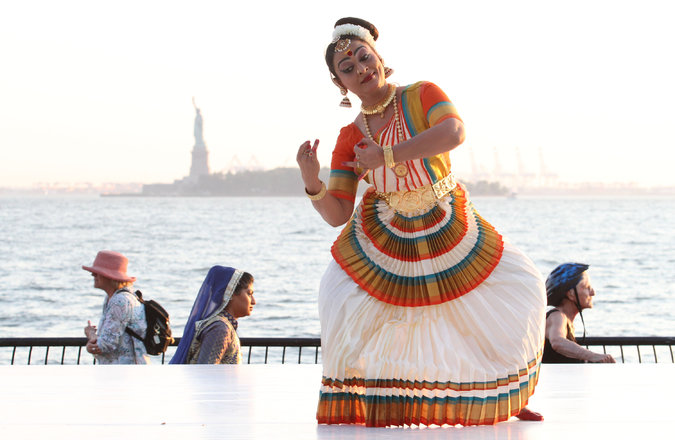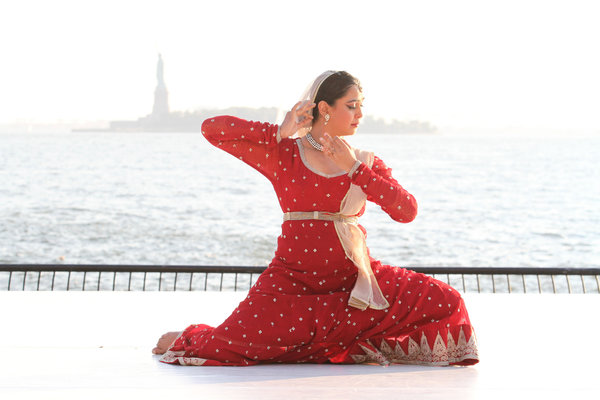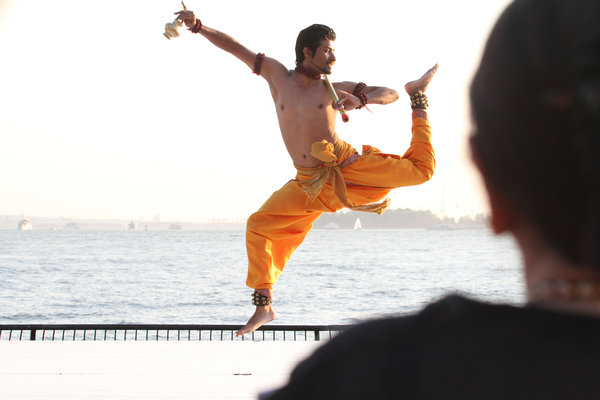
| IAAC ERASING BORDERS FESTIVAL OF INDIAN DANCE | |
| Reviews | |
| nytimes.com Review: Erasing Borders Festival of Indian Dance, a Showcase of Dizzying Movement By ALASTAIR MACAULAYAUG. 16, 2015 |
|
 |
|
| The Mohiniyattam dancer Pallavi Krishnan. Credit Tina Fineberg for The New York Times |
|
Now that the weeklong Battery Dance Festival - an August perennial - has settled on a stage in Robert F. Wagner Jr. Park, it has the best backdrop in New York. The audience sees, behind the dancers, the Statue of Liberty and Ellis Island. Sailboats, cruise boats and yachts pass. Airplanes pass silently above. The drawback is that audience members, at 6:30 p.m., have the early-evening sun in their eyes. Baseball caps or dark sunglasses are advised. This festival is admirably eclectic. This year’s includes the New York debut of Polish Dance Theater (Sunday and Monday), an evening of Colombian dance (Tuesday) and - among many others - two world premieres for the host, Battery Dance. One of them is by the former longtime Martha Graham principal dancer Tadej Brdnik. This year’s festival began on Saturday with the Indo-American Arts Council’s Erasing Borders Festival of Indian Dance, always for me a highlight of the dance year. It was Indian Independence Day: More than a few people were wearing the green, white and saffron colors of the Indian flag. |
|
 |
|
| The Kathak performer Sanjukta Wagh. Credit Tina Fineberg for The New York Times |
|
This year’s anthology included five genres: the exuberant Punjabi folk form Bhangra; the elaborately expressive folk form Chhau (from the eastern state of Odisha); and three of the nation’s classical idioms - Mohiniyattam (from Kerala, in the southwest), Bharatanatyam (from Tamil Nadu, in the southeast) and Kathak (from the north, originally from the courts). The most unusual to Western eyes were the two examples of Chhau, performed by Rakesh Sai Babu. A further ingredient for curiosity was that Mr. Sai Babu is from the royal family of Mayurbhanj in Odisha and was trained by his father. It is a famous part of dance history that ballet was once performed by French royalty, but until now I have had regrettably few examples to review dancing by members of any royal family. Chhau, as the lithe and authoritative Mr. Sai Babu showed it, is a highly complex form, vigorous for the upper and lower body, sometimes asking dancers to hold a balance when they must be most tired. He performed both of his numbers bare-chested and barefoot, in billowing leggings and with the ankle-bells that appear in many Indian dance forms. His first piece, “Dandi,” demonstrated the renunciation of the wandering ascetic. “Yuddha,” the second, was a martial-arts number deriving from the royal court of Mayurbhanj. In both, it was striking how full-bodied his dancing was. As the ascetic, he arched all the way back and sideways; his martial dance was accompanied by memorable shakes of the shoulders. His legs sliced out, in and out again, turning kicks and strides into rhythmically detailed paces. My chief reservations about these examples of Chhau regarded the coarseness of their music: bashing drums and droning pipes. |
|
 |
|
| Rakesh Sai Babu danced two numbers of the folk form Chhau. Credit Tina Fineberg for The New York Times |
|
| The most transporting dances of the program were the three by the Kathak performer Sanjukta Wagh (from Mumbai). As she showed, Kathak is characterized by dizzyingly intricate footwork and many turns, but its stillnesses were yet more beautiful. Ms. Wagh would end a dance not just with a sudden halt (as occurs in all Kathak) but as if she were switching into an exceptional form of repose. During one number, she knelt on the floor and slowly lowered her hands onto her legs so that all you looked at was her marvelous expression of contemplation. I’d love to see her with live music; with no Indian dance form does the responsiveness of music and movement become more enthralling than with Kathak. Moving at high speed, spinning around the stage, she never for a moment lost elegance. And she showed how Kathak makes rhythmic effects with arms, wrists and eyes, as well as with feet. In her final number, “Thumri: Storytelling in Kathak” (expressing aspects of the eternal love of Radha for Krishna), her costume - a full-length, richly red dress topped by a stingingly green veil - was the most ravishing outfit of the evening. I also loved the Mohiniyattam dancing of Pallavi Krishnan (from Thrissur, Kerala). It’s well known that Mohiniyattam is characterized by sensuous side-to-side or circular swaying of the dancer’s torso, but Ms. Krishnan proved a sophisticated stylist who showed many further points of the genre; while the knee and thigh are propelling the torso to tilt one way, the bare foot is pounding out an intricate rhythm. The hands and arms, meanwhile, are communicative. Phrases are long and connected: You follow the dance as if borne downstream on a shifting current. The green and purple costumes of Sonali Skandan and her four Jiva Dance co-performers (from New York) illustrated the peacock. (I had not known until Saturday that this is India’s national bird.) The interplay of the sculptural and rhythmic aspects of Indian dance was compelling here. Among many fine points, the flexing of individual fingers - alwaymore remarkable in the dance forms of Southern Asia than anywhere else - was riveting. New York also provided the closing performance, a Bhangra number delivered by the five women of Shaan Mutiyaaran Di Bhangra. The high energy of this folk genre was originally associated with Punjabi men, but, as has been occurring in recent decades across the terrain of Indian dance, women have felt free to invade it. These five were each dressed in a different bright color; although this was the program’s least subtle item, its powerful pulse, its merrily outgoing force and its occasional jumps made it a winning finale. |
|
| URL:http://www.nytimes.com/2015/08/17/arts/dance/review-erasing-borders-festival-of-indian-dance-a-showcase-of-dizzying-movement.html |